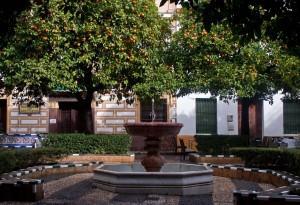 Wandering the narrow streets of the Barrio Santa Cruz in Seville, Spain on a chilly New Year’s Eve two years ago, I was struck by the sight of orange trees full of ripe fruit populating the courtyards and plazas. A local guide showing me around the city cautioned that these oranges were too bitter to eat. Still, sitting on a bench by a burbling fountain looking up at the oranges in the trees above, I imagined for a moment the pleasures of picking an orange and enjoying it there, in the shade on a hot summer day.
Wandering the narrow streets of the Barrio Santa Cruz in Seville, Spain on a chilly New Year’s Eve two years ago, I was struck by the sight of orange trees full of ripe fruit populating the courtyards and plazas. A local guide showing me around the city cautioned that these oranges were too bitter to eat. Still, sitting on a bench by a burbling fountain looking up at the oranges in the trees above, I imagined for a moment the pleasures of picking an orange and enjoying it there, in the shade on a hot summer day.
Having lived mostly in cities located at northerly latitudes, seeing orange trees was a bit of a novelty. But at the same time, so was seeing fruit-bearing trees in the heart of a major city. Urban parks, arboretums, and botanical gardens everywhere have the occasional trees and plants that bear edible fruits and nuts, but I would fathom to guess that in most U.S. cities these are to be found primarily in private backyards (notwithstanding, for example, invasive blackberry bushes such as those endemic in and around Seattle). This has started to change in recent years with increasing discussion of the need to mitigate urban “food deserts,” and the growth of neighborhood community gardens. Joining these community initiatives is a bold new experiment: the largest public food forest in the United States.
Following up on a story posted here earlier this year, Seattle’s Crosscut.com recently reported updates on developments on the Beacon Food Forest, a community-led initiative in Seattle’s diverse Beacon Hill neighborhood that will convert seven acres of idle, public utility-owned land adjacent to a city park into an “edible arboretum” filled with fruit and nut trees, edible plants and berries, and community gardens and classrooms. As author Robert Mellinger writes, driving this project is the concept of permaculture, which he describes as an “ecological design system, philosophy, and set of ethics and principles used to create perennial, self-sustaining landscapes and settlements that build ecological knowledge and skills in communities.”
The article explores in detail the winding path of the Beacon Food Forest from its origins in discussions among neighborhood gardeners, who then carried out significant community outreach to build broad-based support for the concept. It also chronicles the bureaucratic and logistical challenges encountered by advocates as they worked to move this idea from vision to reality. One major challenge—and a common one for many innovative ideas and projects across every sector—was the lack of existing regulations, guidelines, or standards in place governing permaculture projects like this, as it was the first. How do you manage something that’s never been done before?
I would encourage interested readers to review the full Crosscut.com article to learn about ways that supporters of the Beacon Food Forest have succeeded in managing through these challenges thus far. Ground was broken on the Beacon Food Forest earlier this fall, and in December the project was awarded a matching fund grant from the Seattle Department of Neighborhoods to design and build an on-site community gathering building and tool shed. Observing lessons already learned from this experience, Mellinger writes that organizers have
“…seen first-hand the costs and complexity of the interface between citizens, government, and land use; a quagmire that leaves many highly creative, but marginalized cultural communities disenfranchised and disempowered. The Friends of the Food Forest’s experience shows that achieving local food access goals means simplifying the bureaucratic obstacle course to allow for flexible, productive land use and creating easier access to government for the many ethnic groups that comprise its citizenry.”
These elements of the project create important stakes for its success, as the precedents it sets will undoubtedly influence future large-scale urban agriculture initiatives in other major cities.
(Image by Author)

